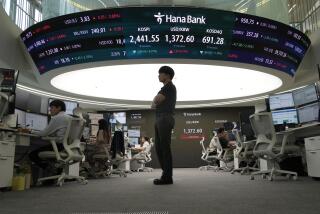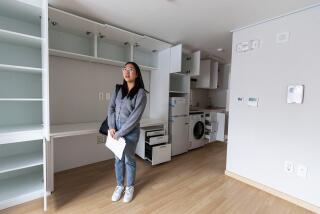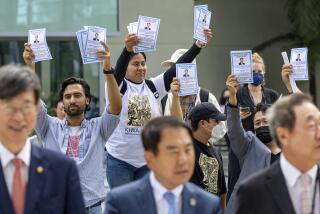S. Korea’s Export Boom Goes Bust : Trade: The surplus is all but wiped out. Gains in money value, labor strife and rising wages are blamed by officials.
- Share via
SEOUL — An export boom that carried South Korea from poverty to the brink of entering the ranks of advanced industrialized nations over the last three decades has sputtered to an end, with no recovery in sight.
A trade surplus that last year amounted to $8.9 billion has been all but wiped out, falling to a minuscule $600 million in the first 10 months this year.
The U.S. trade deficit with South Korea that soared to $9.6 billion only two years ago promises to be slashed by more than half this year, and a further reduction next year appears likely.
For the first time since the country reached an economic takeoff point in the early 1960s, exports this year are acting not as a stimulus to growth but as a drag on it. South Korea will still enjoy real growth of nearly 7% this year, thanks to surging domestic demand led by construction and consumer spending. But some are sounding a warning.
Government officials have blamed appreciation in the value of South Korea’s money, the won, labor strife and soaring wages for sapping the country’s international competitiveness.
The won, however, has been slowly losing value since April 22, and labor strife ended in June. But exports, instead of resuming their growth continue to decline.
After falling in volume by 4.3% in the first quarter, exports declined 4.5% in the second quarter and 7% in the third. Through the first nine months, export volume fell by 5.3%, a startling turnaround from a 16% expansion during the same period last year.
Of the four Asian “tigers”--including Hong Kong, Taiwan and Singapore--South Korea registered the lowest export growth and the steepest climb in imports.
“The labor disputes have stopped but we have not been able to regain competitiveness in the international market,” said Oh Jong Nam, director of the Economic Planning Board’s monitoring and research office.
The outlook is for another round of labor strife next spring as annual wage negotiations get under way.
“We are not sure at all of what our internal environment will be like next year. We don’t know how much labor trouble we will have,” Oh said. As a result, he said, the government is uncertain about predictions.
But one thing is certain, he added. With growth in the United States, Japan and Europe expected to fall, the government’s goal for exports this year of $70 billion will not be reached even next year.
The Bank of Korea predicted that the surplus in current accounts (the balance of both trade and such non-trade transactions as tourism, shipping and insurance payments) would be $4.6 billion this year and fall to $3.4 billion next year. Only last year, it set a record at $14.3 billion.
Oh was even more pessimistic.
“Current accounts could even go into red ink next year,” he said.
Although South Korea suffered as much labor strife in 1988 as it did this year and still enjoyed 12.2% real growth in the economy--the third straight year of 12%-plus growth--the cumulative effects of three years of steep wage boosts hit export competitiveness in full force in 1989.
Productivity that rose 16% in 1987 and 12.9% last year was still gaining at a rate of 9.8% between April and June. But those gains in productivity were outstripped by wage rises of 19.6% last year and 20% this year.
Workers, whose wages were suppressed by the authoritarian government of former President Chun Doo Hwan, continue to believe that they have failed to get their fair share of South Korea’s growth.
Labor strife will not end until some companies are driven into bankruptcy, predicted Park Sung Kyu, president of Daewoo Telecom.
“If we have serious labor trouble next year, this economy is in for big trouble,” added Yoo Jong Hoo of the Korea Development Institute, a government-supported think tank.
Although the Bank of Korea predicted that strong domestic demand would sustain a 7% growth in the economy next year, Oh said government officials were describing South Korea as facing a crisis.
“If you look at the social and political phenomena, we can no longer see a promising future. . . . Everybody is demanding more than our economy’s capacity to provide.”
Criticism of a lack of strong leadership from President Roh Tae Woo, the nation’s first democratically elected president in 16 years, has become so widespread that Roh himself recently acknowledged that he was aware people were calling him President Mul, instead of President Roh. Mul means water, which Koreans are now comparing with their rock-hard leaders of the past.
“The current economic difficulty is only half social. The other half is political,” Yoo said.
Also worrying business and government leaders is a steep decline in investment in production facilities and a creeping buildup in inventories.
On Nov. 11, Roh’s government took its first aggressive step to spur growth by lowering interest rates and promising 1 trillion won ($1.5 billion) in low-interest loans to underwrite investment in new factory equipment.
After years of mushrooming surplus for South Korea in its trade with the United States, the trend has shifted. Not only have exports to the United States fallen by 1.6% for the first nine months of 1989 but imports from the United States grew by 26%.
South Korea’s surplus through October was $3.8 billion, and the projection for the full year is a surplus of about $4.6 billion--a trade deficit for the United States only about half that of last year.
Although electronics exports to the United States remained strong, shipments of cars plummeted 44.5% in the first nine months and are not expected to recover, Yoo of the Korean Development Institute said.
“Unless a sharp increase occurs in the U.S. demand for small cars or Korean manufacturers achieve a sharp increase in quality, auto exports don’t have a big chance to regain the ground they have lost,” he said.
“In the first several years, when the quality (of Korean cars) was unknown to U.S. consumers, sales overshot (the market) that could be maintained,” Yoo said.
Further, new strength in American exports to South Korea is expected to continue. Not only is rising demand at home pulling in more imports, but the steep wage increases are inducing South Korean manufacturers to speed up purchases of labor-saving machinery and office automation equipment from the United States. Partial relaxation of restraints on imports of farm products also is boosting American sales.
The Korean Customs Administration Office reported that U.S. farm exports to South Korea reached $2.7 billion in the first nine months and are expected to total $3.7 billion for the year, a 53% increase compared with 1988.
Huge gains in American sales of machinery, computers, chemical and agricultural products in the first nine months this year are expected to continue, U.S. economists said.
More to Read
Sign up for Essential California
The most important California stories and recommendations in your inbox every morning.
You may occasionally receive promotional content from the Los Angeles Times.










